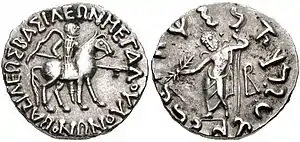Vonones of Sakastan
Vonones (also spelled Vovones) was an Iranian king, who ruled Sakastan from 75 BCE to 57 BCE.[1] During the latter part of his reign, he extended his rule as far as Taxila in north India, minting coins with the title of King of Kings.[1] Vonones was a rival of the first Indo-Scythian monarch Maues (r. 98/85–60/57 BC), who also claimed the title of King of Kings.[2][3] Both of them fought for power over the regions of Arachosia, the Kabul Valley, Ghadhara and Taxila.[4]
| Vonones | |
|---|---|
| King of Kings | |
 Silver tetradrachm minted under Vonones, with the legend of his name and his commander Spalahores. Obverse with Greek legend: ΒΑΣΙΛΕΩΣ ΒΑΣΙΛΕΩΝ ΜΕΓΑΛΟΥ ΟΝΩΝΟΥ, "Of the King of Kings the Great Vonones". | |
| King of Sakastan | |
| Reign | 75–57 BCE |
| Predecessor | Unknown |
| Successor | Spalahores |
| Died | 57 BCE |
Vonones' origins are uncertain.[4] His name (lit. meaning "victor") was of Parthian origin, used by the royal Arsacid family of Iran.[1][2] Because of this, arguments have been made in favour of a Parthian Surenid origin.[4] According to the Iranologist Khodadad Rezakhani, Vonones belonged to the royal Arsacid family.[5] Others, however, claim that he was an Indo-Scythian, regardless of his Parthian name.[4] The legend of Vonones' coins also had the name of two of his commanders Spalahores and Spalirisos, who are referred to as "brother of the king".[1] Scholars such as R.C. Senior and Rezakhani consider the two figures to indeed be Vonones' brothers,[6][7] while others such as K.W. Dobbins argue that it was a honorific title given to them, whom he considered to be Saka satraps.[8][lower-alpha 1]
A major argument against the proposal of a blood relationship between Vonones and the two commanders was due to both of them having Saka names, contrary to Vonones' Parthian name.[4] Saghi Gazerani has suggested that after the Arsacid re-conquest of Sakastan (sometime between 124 BCE and 115 BCE), which was given as a fiefdom to the Surenid general that led the expedition, the Surenids (who became independent after 88 BCE) and the Sakas became closely connected, presumably through alliances and intermarriages.[9] Indeed, the Parthians and Sakas are often confused in Indian literature.[3] The mythological Iranian hero Rostam (who was from Sakastan), is mentioned in Iranian traditions as both Parthian and Saka, thus supporting this dual-identity.[3]
Vonones was succeeded by Spalahores.[10] The latter's son and successor, Spalagadames, has been suggested by Rezakhani to be the same figure as the first Indo-Parthian king, Gondophares (r. 19–46 CE).[11]
Notes
- Rezakhani has additionally suggested that Spalahores may simply have been a military title used by Vonones.[5]
References
- Gazerani 2015, p. 15.
- Rezakhani 2017, p. 33.
- Gazerani 2015, p. 17.
- Gazerani 2015, p. 16.
- Rezakhani 2017, p. 34 (note 20).
- Gazerani 2015, pp. 15–16.
- Rezakhani 2017, p. 34 (see also note 20).
- Gazerani 2015, p. 16 (see also note 18).
- Gazerani 2015, p. 16–17.
- Rezakhani 2017, p. 34.
- Rezakhani 2017, pp. 34, 37.
Sources
- Gazerani, Saghi (2015). The Sistani Cycle of Epics and Iran's National History: On the Margins of Historiography. BRILL. pp. 1–250. ISBN 9789004282964.
- Rezakhani, Khodadad (2017). "East Iran in Late Antiquity". ReOrienting the Sasanians: East Iran in Late Antiquity. Edinburgh University Press. pp. 1–256. ISBN 9781474400305. JSTOR 10.3366/j.ctt1g04zr8. (registration required)
| Preceded by Unknown |
King of Sakastan 75–57 BCE |
Succeeded by Spalahores |